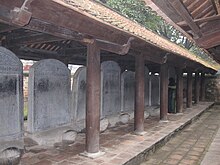Literary Chinese in Vietnam
Literary Chinese
Literary Chinese was a style of writing modelled on the classics of the
Literary Chinese as written in Vietnam used the same characters and outward form as in China. Although Literary Chinese was used only for written communication, each
The Vietnamese terms for writing in Chinese are chữ Hán ('Han characters') or chữ Nho ('Scholars' characters') in contrast to chữ Nôm ('Southern script'), a script for the Vietnamese language.[6][7] The Nôm script, using a mixture of Chinese characters and locally created characters, became the vehicle for a flourishing vernacular literature, peaking in the late 18th and early 19th centuries. However, Literary Chinese remained the medium of scholarship and administration for almost all of the period until the early 20th century.[8]
History



The northern part of Vietnam (down to about the 17th parallel) was incorporated into the
After the country achieved independence in 938, it continued to use
After three short-lived dynasties, the
When the Chinese
- a Call to the Officers of the Army, issued in 1285 when the country was facing a Mongol invasion,
- Return to the Capital, a poem celebrating the expulsion of the Mongols in 1288,
- the Ming occupationin 1428, and
- an Qing empirein 1789.
The influence of Confucian literati grew in the following

Literary Chinese remained the language of administration throughout the traditional period, except during two short-lived reformist regimes. When
The shared written language made it possible for Vietnamese scholars to communicate with literate Chinese and Koreans, but only in writing. They required interpreters for verbal communication.

Vietnamese intellectuals continued to write in Chinese until the early decades of the 20th century. For example, the nationalist Phan Bội Châu (1867–1940) wrote his History of the Loss of Vietnam (1905) and other tracts in Literary Chinese, and also used it to communicate when in Japan and China, as he spoke neither Japanese nor Chinese.[3] Writers such as Phan Bội Châu, Phan Châu Trinh, and the principal of the Tonkin Free School even used Chinese to write their attacks on education in Chinese and the examination system.[22] On the other side, the French colonial authorities were also opposed to Chinese, both because it made administration more difficult for them, and because of the nationalist literature being circulated in the language.[23] The French abolished the examination system in 1913, and both Literary Chinese and chữ Nôm were swiftly replaced by the Latin-based Vietnamese alphabet in the early 20th century.[24] In modern Vietnam, Chinese characters are seen only singly or in stock phrases written by calligraphers.
References
- ^ Nguyễn, Tri Tài (2002). Giáo trình tiếng Hán. Tập I: Cơ sở. Nhà xuất bản Đại học Quốc gia Thành phố Hồ Chí Minh. p. 5.
- ^ Norman (1988), p. 83.
- ^ a b Kornicki (2011), p. 67.
- ^ a b DeFrancis (1977), p. 16.
- ^ Alves (2009), p. 623.
- ^ DeFrancis (1977), pp. 26–27.
- ^ Nguyen (1990), p. 383.
- ^ DeFrancis (1977), pp. 31–32, 40–44.
- ^ DeFrancis (1977), p. 3.
- ^ DeFrancis (1977), p. 10.
- ^ a b c DeFrancis (1977), p. 14.
- ^ Coedès (1966), p. 87.
- ^ DeFrancis (1977), p. 16, 18.
- ^ Nguyen (1981).
- ^ Taylor (1983), pp. 350–359.
- ^ Taylor (1983), pp. 352–357.
- ^ DeFrancis (1977), pp. 31–32.
- ^ DeFrancis (1977), pp. 40–44.
- ^ DeFrancis (1977), p. 35.
- ^ Woodside (1971), pp. 114–115.
- ^ DeFrancis (1977), p. 36.
- ^ DeFrancis (1977), p. 178.
- ^ DeFrancis (1977), pp. 178–179.
- ^ Hannas (1997), pp. 84–90.
Cited books and articles
- Alves, Mark J. (2009), "Loanwords in Vietnamese", in Haspelmath, Martin; Tadmor, Uri (eds.), Loanwords in the World's Languages: A Comparative Handbook, De Gruyter, pp. 617–637, ISBN 978-3-11-021843-5.
- ISBN 978-0-520-05061-7.
- ISBN 978-90-279-7643-7.
- Hannas, Wm. C. (1997), Asia's Orthographic Dilemma, University of Hawaii Press, ISBN 978-0-8248-1892-0.
- ISBN 978-81-920651-1-3.
- ISBN 978-0-521-29653-3.
- Nguyen, Dinh-Hoa (1981), "Patriotism in classical Vietnamese literature: evolution of a theme", in Tham, Seong Chee (ed.), Literature and Society in Southeast Asia, NUS Press, pp. 303–320, ISBN 978-9971-690-36-6.
- ——— (1990), "Graphemic borromings from Chinese: the case of chữ Nôm – Vietnam's demotic script" (PDF), Bulletin of the Institute of History and Philology, 61 (2): 383–432.
- Taylor, Keith Weller (1983), The Birth of Vietnam, University of California Press, ISBN 978-0-520-07417-0.
- Woodside, Alexander (1971), Vietnam and the Chinese Model, Harvard Univ Asia Center, ISBN 978-0-674-93721-5.
